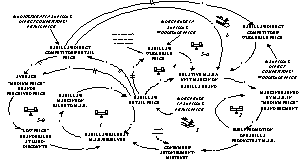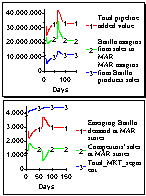 Fig.1: Main feedback loops
Fig.1: Main feedback loops
ABSTRACT
On February 13th 1996, Barilla S.p.A. - a major Italian food producer (of mainly pasta, biscuits and snacks) - in order to face emerging competition from anonimous brands which were becoming more and more popular, particularly at hard-discount stores, suddenly announced its new strategy not to operate anymore gift sales promotions and to decrease retail prices on average by 10%. Such a strategy was justified by a sales increase as well as a marketing, warehousing and financial costs decrease forecast. Even though successful results were obtained by Barilla, some logistic and commercial problems arose downwards in the supply chain.
As the paper will show, with particular reference to pasta business, the above strategy affected policies adopted by M.A.R., an Italian hyper and supermarkets medium-sized chain, which produced a sales and inventory instability, as well as a profit decrease in the supply chain. It will be demonstrated how System Dynamics may support a deeper comprehension of relevant feedback loops underlying management processes along the pipeline and a cooperation between companies located in different segments of the supply chain. In this perspective, dynamic modelling and simulation may be seen as a useful framework to implement Efficient Consumer Response (E.C.R.), a worldwide programme involving both producers and distributors, to increase overall supply chain added-value.
In about 1995, a market survey promoted in Italy by Barilla S.p.A. showed that 80% of its consumers was not anymore interested in sales promotions based on gifts and that brand loyalty was mainly related to quality and price . The results of this survey suggested Barilla to abandon gift promotion strategy (whose costs were about 7% of sales revenues), to decrease retail prices on average by 10% and to keep unchanged quality standards. The decision to adopt such policy has been called "the big event" as it gave rise to a daring product repositioning which is a rare example of how to sharply change the "rules of the game" in a consumer goods market. If we particularly refer to the business of pasta, where Barilla mainly operates in the medium and top price segments , a price decrease was expected to cause a higher brand loyalty, leading to a more than proportional increase in sales. In fact, it was estimated that about 23% of Barilla sales in the medium price segment is made up by consumers who are used to changing their favourite brand according to different conditions. Barilla's potential market is by far bigger: if we also consider the lower and upper segments, the share of "non-loyal" Barilla's customers rises up to 60% of its total sales. It is not so easy, however, to increase customer loyalty. In fact, about 70% of "non-loyal" customers is made-up by those who are particularly used to buying low price brands at hard-discount stores. The Italian pasta market is characterized by a very strong competition: it is not only crucial to meet customers' quality requirements and to sell products on a relatively low price/quality ratio, but it is also becoming more and more important to establish cooperative strategies with distributors. Improving formal and informal relationships with other companies operating downwards in the supply chain is particularly significant for Barilla, whose area of activity is bounded in the industrial segment, while a serious threat is coming from trade labels (e.g.: Rinascente, Esselunga, Coop), which have been strongly growing in the last decade. Consequently, an aggressive price strategy would be likely to generate positive events if Barilla could improve its contacts with medium-sized distribution companies and particularly with those which are located in geographic areas where neither big trade companies nor hard-discount stores hold market leadership. A more fragmented distribution structure in Italy is found in the South and Centre of the country, where also M.A.R. (a medium hyper and supermaket chain) operates.
In the next pages the paper will show how unexpected Barilla's price reduction affected MAR's policies which affected, in turn, supply chain added value dynamics.
Through an on-line information system Barilla is able to support its customers' (distributors) reorder policy with the aim to reduce inventory, set-up and administration costs along the supply chain, to improve overall added value. When Barilla, in order to fix diminishing profits due to strong market competition, suddenly decreased its "on-shelf" retail price and sale price to distributors, it suggested MAR to immediately raise its supply orders as a higher demand was expected (negative loop 1-fig.1). Nevertheless, in the next weeks after the big event, MAR on the contrary reduced its supply orders, as Barilla products retail sales decreased. Such unexpected phenomenon was caused by two main related reasons: 1) a mixture of consumers' astonishment,
 Fig.1: Main feedback loops Fig.1: Main feedback loops | puzzlement and also mistrust (in spite of massive Barilla's "reassuring" advertising) on the oppor-tunity to choose a "discounted" brand whose la-bel has always been a synonimous of higher pri-ce and quality; 2) a lower on shelf sales support by MAR, caused by a drop of its relative unit margins on existing inventories (loop2). In other |
words, MAR was forced to sell at a lower retail price those inventories which had been purchased
 Fig. 2-a: Main causal determinants of supply chain added value and of Barilla's and MAR's profits Fig. 2-a: Main causal determinants of supply chain added value and of Barilla's and MAR's profits | before the big event, i.e at a higher unit cost. The above phenomena eventually led to lower Barilla profits, which reinforced the need of low prices and, consequently, perpetuated MAR's reactions (loop 3). Such dynamics may be related to the Accidental Adversaries archetype. Positive loop dominance lasted | |
 Fig:2-b: Main sectors of the model related to materials and orders flows in the supply-chain Fig:2-b: Main sectors of the model related to materials and orders flows in the supply-chain | grow, because of two main reasons: 1) MAR's unit margin on Barilla products restore (loop4), which im-plied a stronger on shelf promotion; 2) delayed effects | |




for a few weeks, until old inventories were sold. Then, Barilla sales at MAR's shelves started to of massive Barilla's advertising. After another delay, competitors reduced their prices too. Such reaction produced three sequential effects: a) a higher relative MAR's unit margin on Barilla products (loop 5-a), which gave rise to a stronger sales support "on shelf", i.e. higher Barilla sales (loop 3 again); b) a lower average price perceived by consumers, which led to a small increase in potential market (loop 5-b) that also strengthened loop 3; c) system's reset on a new equilibrium (after MAR depleted other medium price brand inventories) which switched again relative unit margin and other master variables to their initial values (left-hand side of fig. 3 and 5). So the big event main outcome, in the case studied, has been too weak a demand increase, if compared to price reduction. If Barilla increased its profits, because of a sharp promotion costs cut, both MAR and the whole chain (Barilla + MAR) margins would drop (left-hand side of fig.3 and 5).
|
Fig. 5: Comparative results from two model's simulation runs, based on actual poli- cies (on the left) and on a concerted reorder, price and "on shelf" sale support policy | A second simulation run suggests that (other con-ditions being equal) bet-ter results (right-hand si-de of fig. 3 and 5) could have been achieved by both companies, if they would have concerted a policy to increase more final sales and to reduce interface costs. The first goal could have been pursued through a higher and faster unit purchase cost reduction allowed by Barilla to MAR, leading to a higher on shelf support to Barilla product sales. The second goal could have been pursued by a more concerted inventory and reorder policy aimed at reducing financial and administration costs. |
CONCLUSIONS
In this perspective, System Dynamics offers a useful framework to implement Efficient Consumer Response (E.C.R.) , a worldwide programme involving both producers and distributors, whose goal is to increase overall supply chain added-value and customer service.